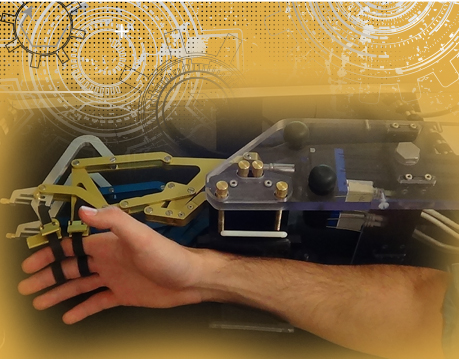Picture and more explanations from here:
https://www.asme.org/engineering-topics/articles/robotics/designing-a-soft-robot

http://www.jneuroengrehab.com/content/11/1/10/abstract
Journal of NeuroEngineering and Rehabilitation 2014, 11:10
doi:10.1186/1743-0003-11-10
Published: 4 February 2014
Published: 4 February 2014
Abstract (provisional)
Background
This paper describes the design and preliminary testing of FINGER (Finger Individuating
Grasp Exercise Robot), a device for assisting in finger rehabilitation after neurologic
injury. We developed FINGER to assist stroke patients in moving their fingers individually
in a naturalistic curling motion while playing a game similar to Guitar Hero(R)1.
The goal was to make FINGER capable of assisting with motions where precise timing
is important.
Methods
FINGER consists of a pair of stacked single degree-of-freedom 8-bar mechanisms, one
for the index and one for the middle finger. Each 8-bar mechanism was designed to
control the angle and position of the proximal phalanx and the position of the middle
phalanx. Target positions for the mechanism optimization were determined from trajectory
data collected from 7 healthy subjects using color-based motion capture. The resulting
robotic device was built to accommodate multiple finger sizes and finger-to-finger
widths. For initial evaluation, we asked individuals with a stroke (n = 16) and without
impairment (n = 4) to play a game similar to Guitar Hero(R) while connected to FINGER.
Results
Precision design, low friction bearings, and separate high speed linear actuators
allowed FINGER to individually actuate the fingers with a high bandwidth of control
(-3 dB at approximately 8 Hz). During the tests, we were able to modulate the subject's
success rate at the game by automatically adjusting the controller gains of FINGER.
We also used FINGER to measure subjects' effort and finger individuation while playing
the game.
Conclusions
Test results demonstrate the ability of FINGER to motivate subjects with an engaging
game environment that challenges individuated control of the fingers, automatically
control assistance levels, and quantify finger individuation after stroke.
Treat your fingers using finger weights to maintain finger strength.
ReplyDeletehand rehabilitation